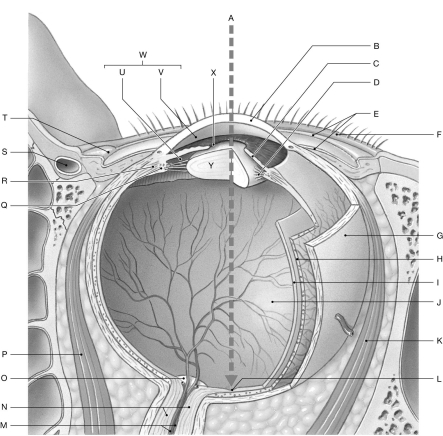A) are located in pockets in the frontal bones.
B) produce most of the volume of tears.
C) produce a slightly acidic secretion that contains lysozyme.
D) A and B only
E) all of the above
Correct Answer

verified
Correct Answer
verified
Short Answer
_________________________ cells connect photoreceptors to ganglion cells.
Correct Answer

verified
Correct Answer
verified
Multiple Choice
A movement in the vertical plane, such as falling straight down while the body maintains the anatomical position, would be sensed by the
A) utricles.
B) saccules.
C) organ of Corti.
D) supporting cells.
E) cochlea.
Correct Answer

verified
Correct Answer
verified
Multiple Choice
The lens of the eye thickens when the
A) conjunctiva contracts.
B) ciliary muscles relax.
C) ciliary muscles contract.
D) ciliary processes contract.
E) suspensory ligaments pull on the lens.
Correct Answer

verified
Correct Answer
verified
Multiple Choice
As nerve fibers from the retina travel to the brain, axons from the
A) nasal half of each eye cross over.
B) otic half of each eye cross over.
C) retinas of both eyes do NOT cross over.
D) retinas of both eyes ALL cross over.
E) none of the above
Correct Answer

verified
Correct Answer
verified
Short Answer
 Using the figure above, identify the labeled part.
-Label J: ________
Using the figure above, identify the labeled part.
-Label J: ________
Correct Answer

verified
Correct Answer
verified
Multiple Choice
Chemoreceptors are located in the
A) carotid and aortic bodies.
B) special senses of taste and smell.
C) respiratory control center of the medulla.
D) A and B only
E) all of the above
Correct Answer

verified
Correct Answer
verified
Multiple Choice
When all three cone populations are stimulated, one sees
A) red.
B) blue.
C) green.
D) white.
E) black.
Correct Answer

verified
Correct Answer
verified
Multiple Choice
The daily day/night cycle known as a circadian rhythm is established in the
A) lateral geniculates.
B) medial geniculates.
C) pineal gland.
D) hypothalamus.
E) both A and C
Correct Answer

verified
Correct Answer
verified
Short Answer
Swellings in the semicircular canals are called _________________________.
Correct Answer

verified
Correct Answer
verified
Multiple Choice
The fibrous tunic of the eye
A) consists of the sclera and the cornea.
B) provides mechanical support and some protection for the eye.
C) serves as a point of attachment for extrinsic eye muscles.
D) A and C only
E) all of the above
Correct Answer

verified
Correct Answer
verified
Short Answer
A(n) _________________________ is an abnormal lens that has lost its clarity.
Correct Answer

verified
Correct Answer
verified
Short Answer
 Using the figure above, identify the labeled part.
-Label P: ________
Using the figure above, identify the labeled part.
-Label P: ________
Correct Answer

verified
Medial rec...View Answer
Show Answer
Correct Answer
verified
View Answer
Multiple Choice
The sensory receptors of the semicircular canals are located in the
A) saccules.
B) ampullae.
C) cristae.
D) utricles.
E) both A and D
Correct Answer

verified
Correct Answer
verified
Multiple Choice
The lens focuses light on the photoreceptor cells by
A) moving up and down.
B) moving in and out.
C) changing shape.
D) opening and closing.
E) dilating and constricting.
Correct Answer

verified
Correct Answer
verified
Short Answer
_________________________ sense changes in the amount of heat energy.
Correct Answer

verified
Correct Answer
verified
Multiple Choice
Which of the following extrinsic eye muscles is responsible for enabling the eye to look upward?
A) inferior rectus
B) medial rectus
C) superior rectus
D) inferior oblique
E) superior oblique
Correct Answer

verified
Correct Answer
verified
Multiple Choice
The ciliary muscle helps to
A) control the amount of light reaching the retina.
B) control the shape of the lens.
C) control the production of aqueous humor.
D) move the eyeball.
E) both A and B
Correct Answer

verified
Correct Answer
verified
Multiple Choice
Which descending pathway in the spinal cord is responsible for carrying reflex information maintaining postural muscle tone?
A) vestibulospinal
B) corticospinal
C) medial and lateral pathways
D) posterior column
E) spinocerebellar
Correct Answer

verified
Correct Answer
verified
Short Answer
A substance that tastes sour most likely contains _________________________.
Correct Answer

verified
Correct Answer
verified
Showing 81 - 100 of 118
Related Exams